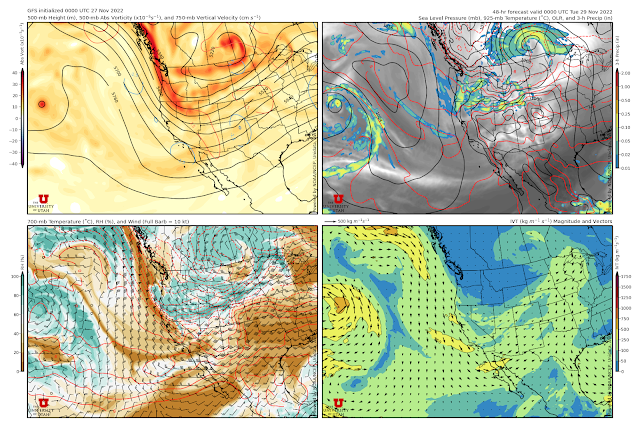By popular demand, output from the the European Center for Medium Range Weather Forecasting (ECMWF) High Resolution Forecast (HRES) is now available on weather.utah.edu.
The HRES goes by many names. It is sometimes called the ECMWF, the EC, the Euro, or even one of those with "Deterministic" added to the end (e.g., the EC Deterministic). On weather.utah.edu I am labeling it the HRES because that is what the ECMWF calls it.
The HRES is a global forecast produced using ECMWFs Integrated Forecast System (IFS) with an effective grid spacing of approximately 9 km. It is the highest-resolution and on average the most accurate global forecast produced by any forecast center.
Much is made about the rankings of the various forecast models, but it is a bit like the NFL standings. Some teams are better than others, but on any given Sunday, upsets happen. One metric of model performance is the 5-day forecast 500-mb geopotential height anomaly correlation coefficient, a measure of the accuracy of the upper-level flow pattern. Below are the 500-mb geopotential height anomaly correlation coefficients from several major global forecast models over the past month. The HRES (labeled ecm below, red line) is consistently near the top, but there are days when the UK Met Office (ukm, yellow-brown), GFS (black), or Canadian (CMC, green line) beat it.
 |
| Source: NOAA/NWS/NCEP |
Thus, it is best to use the HRES not in isolation, but in consultation with other forecast modeling systems.
In the United States, operational forecast model output is freely available and not subject to copyright. This is why I can create and distribute plots based on the GFS and HRRR on weather.utah.edu. This is not the case for ECMWF model output. Only recently has ECMWF begun to provide some of the forecast model guidance publicly. The new HRES plots on weather.utah.edu are based on ECMWFs "Open Data" feed, which is governed by the Creative Commons CC-4.0-BY license so that plots can be created, distributed, and provided publicly.
That being said, the open data HRES dataset is produced at 0.4˚ grid spacing (the HRES runs at about 0.1˚) and only a limited number of variables are available. For the 00 UTC and 12 UTC runs, forecast products are available every 3 hours to 144 hours and every 6 hours from 150 to 240 hours whereas for the 06 UTC and 18 UTC runs products are only available to 90 hours. Products are also available relatively late.
On weather.utah.edu you will see two options for the HRES, "ECMWF HRES (240 h)" which will provide the 00 and 12 UTC initialized runs to 240 h and "ECMWF HRES (90 h) which will provide all four runs to 90 h. The plots are the same as those produced for the GFS 0.25˚ grids except: (1) there are no dynamic tropopause products available, (2) vertical velocity is not available on the synoptic plots, and (3) synthetic satellite imagery (OLR) is not available). Below are comparisons of last night's 00 UTC HRES and GFS forecasts valid 0000 UTC 29 November (5 PM MST Tuesday).



You mentioned that the effective grid spacing is around 9 km. What is the effective grid spacing of the higher-resolution HRES products offered by pivotal?
ReplyDeleteI'm on my way back from Cabo reading on my phone, just read again. I now see what you are getting for free and redistributing is 4° horizontal grid spacing which looks to translate to 36km. I use weather.us to look at free ECMWF data but will now use weather.utah.edu more often.
Deletesuper useful Jim, Alta snow safety uses them everyday!!
ReplyDeleteMany, many thanks for providing the ECMWF. Any chance you might replace the 925mb temp with the 1000-500mb thickness instead?
ReplyDeleteNo. The 925-mb temps have some uses for class that I need.
DeleteWhere is the anomaly correlation coefficient chart published? Having a hard time finding that chart. Thanks in advance.
ReplyDelete